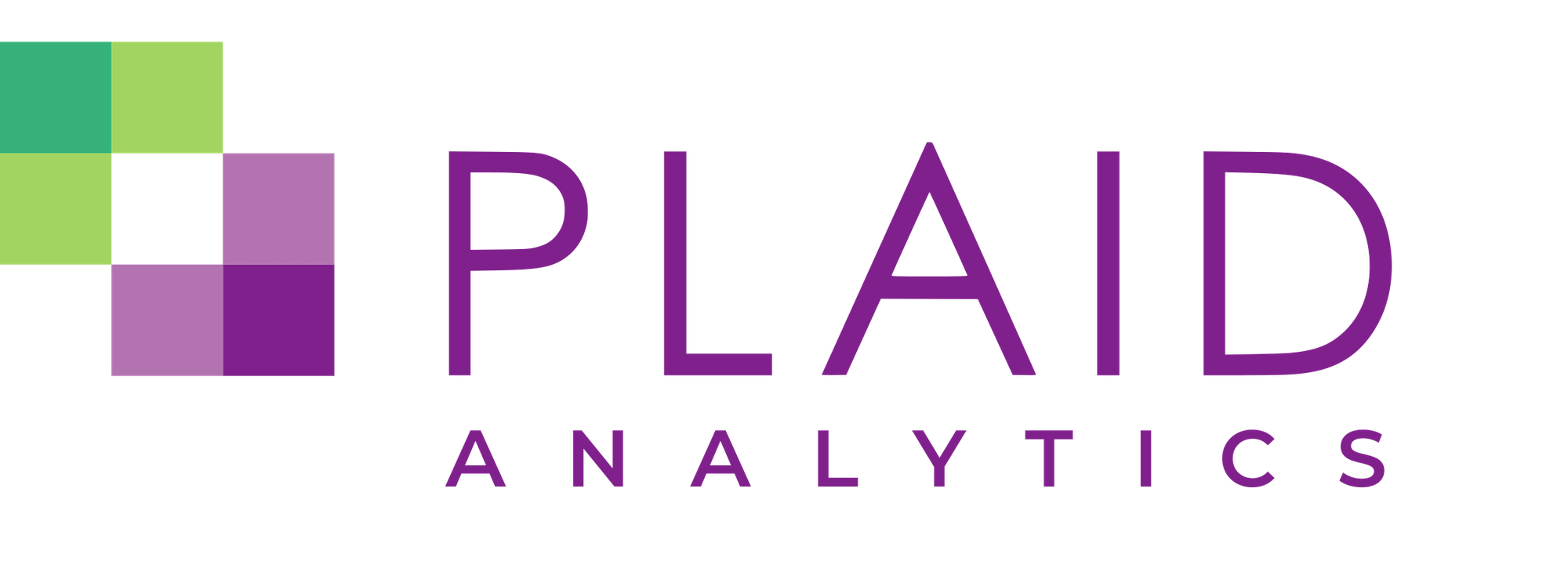Is New Brunswick Being Shortchanged on International Student Allocation?

Edit: Apr 5, 12:05pm PT. Minister Miller just issued a press release with better insights and rationale on allocations. It likely will change some of the projections and assertions in this post. See the press release for details. The original article follows, unedited for now.
With major changes to Canada’s international student visa allocation rules beginning this year, it has been an exciting/nerve-wracking period for enrolment planning in Canada. New Brunswick is our focus today, and this analysis suggests they are being short-changed on allocations relative to their share of the population.
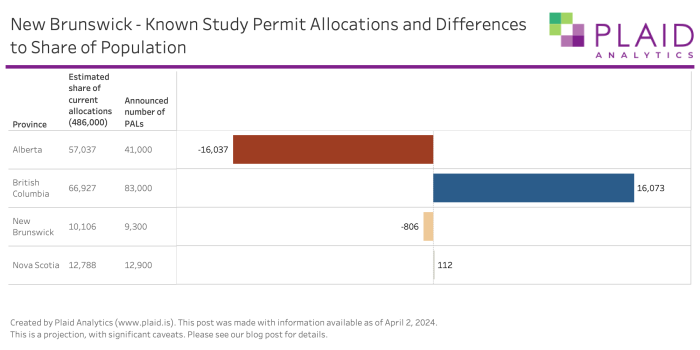
From the chart, it’s clear that New Brunswick is receiving fewer seats than it should based on population. That shortfall of about 800 students relative to population could mean about $14m to the institutions of New Brunswick in the first year alone, which will compound each year until growth resumes.
As of April 3, 2024, four provinces had announced their planned Provincial Attestation Letter (PAL) allocations: Alberta, British Columbia, New Brunswick, and Nova Scotia. Our summary of allocations to date is shown in the table here:
Having this allocation information allows us to begin projecting five-year impacts to institutions and jurisdictions.
New Brunswick’s Allocations: 2023 and 2024
In 2023, New Brunswick’s approvals were 6,917 but they had only a 38.1% approval rate over the period 2021-2023 (via ApplyBoard), which implies about 18,150 applications.
In 2024, the federal government has allocated only 9,300 seats (rather than the 10,100 that is implied by population). This would hurt less if New Brunswick had an approval rating more in line with the national 59% average.
Please note: Scenarios are based on public data, not internal institution data.
Canada has very limited public data on higher education, and it's almost always out of date. The following projections rely on this data, but should be taken with a grain of salt.
Forecast Results – Provincially
Overall, with this allocation of seats, we’ll see New Brunswick’s post-secondary sector grow modestly from 2024 onwards. That growth is carried by the province’s universities, while the colleges are projected to decline international enrolments. Much of that decline in college enrolments is due to the allocation to New Brunswick Community College, discussed next.
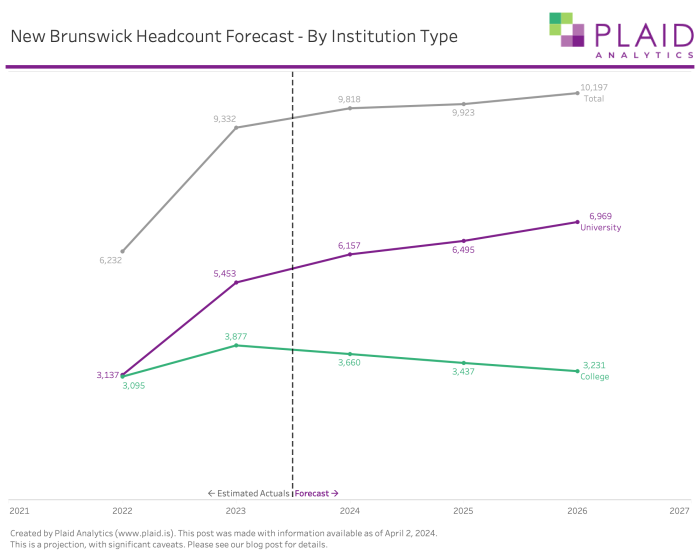
Forecast Results – Selected Institutions
Among institutions, let’s look at the four largest: University of New Brunswick (UNB), Université de Moncton (UM), New Brunswick Community College (NBCC), Collège communautaire du Nouveau-Brunswick (CCNB).
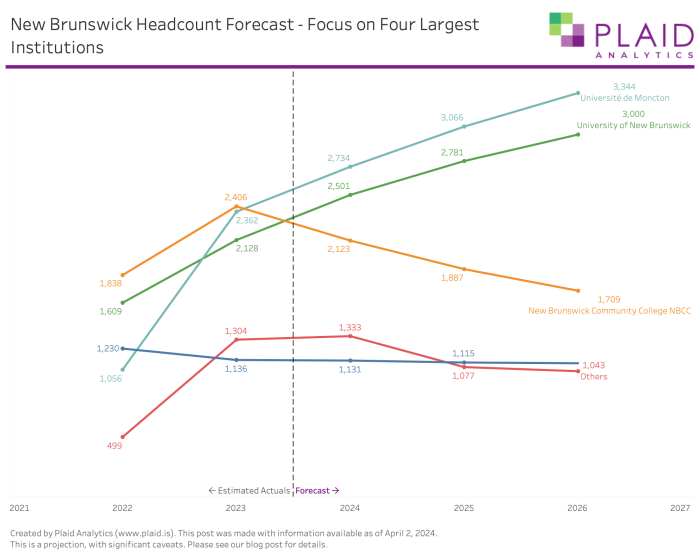
Our forecast suggests CCNB will face the least collateral damage. In our view, the challenges CCNB has faced with domestic students, and keeping capacity there for international students, will better ensure the institution survives.
We project UNB and UM will continue to grow. At UNB, this is a combination of graduate and undergraduate growth. At UM, the number of approvals tripled between 2021 and 2023: from 616 to 939 to 1939 in three years. Given that kind of growth rate, their overall international student population will continue to grow for a while under almost any scenario.
Conversely, Crandall University, a private institution, has been allocated only 15 applications. They had 9 international students in 2023 according to the Telegraph-Journal, while IRCC say they approved 454 visas in 2023 (a 98% melt rate!), which may be indicative of agent behaviour and a student preference for accreditation and credentials from a public institution, which benefits the skilled-worker Permanent Resident pathways. (It may also be indicative of a data problem somewhere.)
Meanwhile, Eastern College, another private institution, will be able to grow into their allotment.
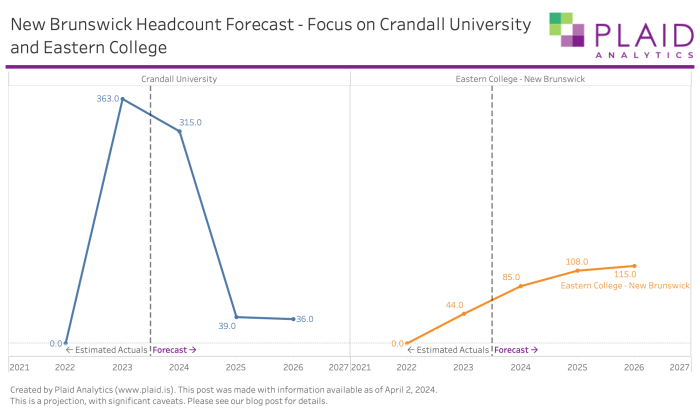
Impact on New Brunswick’s Growth Plans
This limited international enrolment growth may give pause for thought on whether the Government of New Brunswick’s population growth strategy will be achievable. That 2019-2024 strategy relies mainly on immigrant recruitment. Importantly, the strategy includes a committee dedicated to increasing “collaboration on immigration matters across government to provide a cohesive and collaborative approach to support newcomers within [New Brunswick’s] communities […]. This committee focuses on various aspects of newcomer integration, including pre-employment training, employment, education … (etc)”.
The plan explicitly states
“With the increased competition for skilled labour, the potential to transition international students into permanent residents in New Brunswick is a significant opportunity. International students are particularly desirable candidates for permanent residency because of their Canadian credentials, proficiency in one or both languages, entrepreneurial skills and familiarity with Canadian culture. “
Further:
“To leverage this growth opportunity, it is imperative that New Brunswick invest in initiatives that will significantly enhance the capacity to attract, integrate and retain international students”.
Background & Data Sources
On January 22nd, Immigration Minister Marc Miller announced a 35% year over year cut in international study permits. Nominally, this could have amounted to a drop from 500,000 to 365,000 study permits, which could equate to a major sector-wide budget cut of between $3-5b, depending on the proportional tuition rates charged by colleges. But the reality is more nuanced. The goal was to cut to 365,000 students, but the federal minister of Immigration actually has no ability to achieve this because they’re not in charge of provincial higher education. Instead, the federal government is capping the number of visa applications at 606,250. If we assume a national average of 60% approval rating leaves us at about 365,000 students ultimately approved. We also know that the federal government has only allocated 486,000 seats to provinces/territories, and are holding 120,000 in reserve. This is to give them some wiggle room if needed – either to open up the taps or to hold the line. Nominally, allocations to provinces were based on population, but the reality has been different.
Data sources used in this projection:
- IRCC study permits
- Apply Board for approval rates
- Undergraduate approval information from the Telegraph Journal: Impact of study caps on each institution
- PSIS data was used for public universities. PSIS is Fall-only, but for universities this is likely to be a reasonable estimate of full-year enrolment. Note that PSIS latest data is only to 2021, which means that 2022 and 2023 are estimates rather than real actuals.
- NBCC annual report was used for NBCC, in particular 1,837 from page 9. PSIS (Fall-only, 1,170) substantially under-reports their number.
- CCNB used PSIS data (783 international students in Fall 2021) adjusted by the same proportion as NBCC’s annual-report-to-PSIS ratio (1837/1170 = 1.57x, 783 * 1.57 = 1229).
- Additional methods described in our previous blog post.
What do You Think?
Is your institution projecting different kinds of outcomes that we’re showing here? I’d love to hear from you to learn more about how our methodologies are different.
Learn More
Plaid Analytics is building the world’s leading enrolment forecasting platform. Mobile-friendly, accurate, and adaptable for your institution’s unique needs, Plaid Forecast is a game changer for how you create your enrolment plan. In addition, you can use these tools to help inform your executive and board members with evidence and arguments to take to government for funding new programs, or illustrating the impact of cutbacks on students, staff, faculty and how those impact into the wider economy.
Curious to learn more about our projections?
- Join our webinar on April 10 (11am PT / 2pm ET).
- Stay tuned for blog posts on other provinces in April.
- Subscribe to our newsletter on www.plaid.is.
Interested in a custom demo of our tools for your institution or government agency?
- Contact Andrew Drinkwater at andrew@plaid.is
